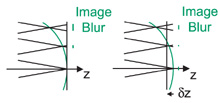Optipedia • SPIE Press books opened for your reference.
Field Curvature
Excerpt from Field Guide to Geometrical Optics
Field curvature characterizes the natural tendency of optical systems to have curved image planes. A positive singlet has an inward bending image surface.


A perfect image is formed on a curved surface, and the image blur at the paraxial image plane increases as H2. A compromise flat image plane that reduces the average image blur occurs inside paraxial focus.

The field curvature is a bias curvature for the astigmatic image surfaces.
| Sagittal surface: | ΔW20 = –W220H2 |
| Medial surface: | ΔW20 = –W220H2–.5W222H2 |
| Tangential surface: | ΔW20 = –W220H2–W222H2 |
| Petzval surface: | ΔW20 = –W220H2 + .5W222H2 |
While not a good image surface, the Petzval surface represents the fundamental field curvature of the system. It depends only on the construction parameters of the system: surface curvatures and element indices of refraction.
These four image surfaces are equally spaced and occur in the same relative order: T-M-S-P or P-S-M-T. The best image quality occurs at medial focus. An artificially flattened field or medial surface can be obtained by balancing astigmatism and field curvature.
J. E. Greivenkamp, Field Guide to Geometrical Optics, SPIE Press, Bellingham, WA (2004).
View SPIE terms of use.

